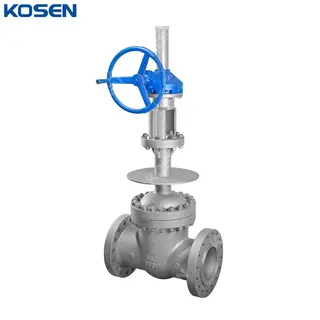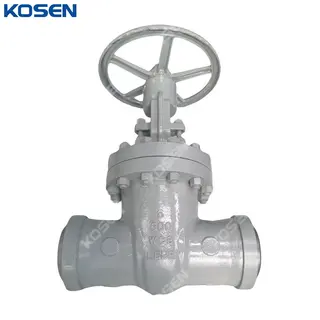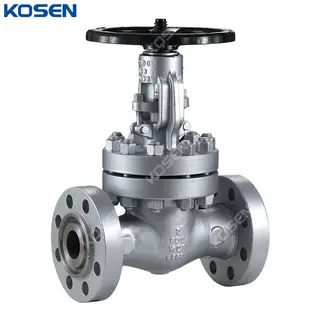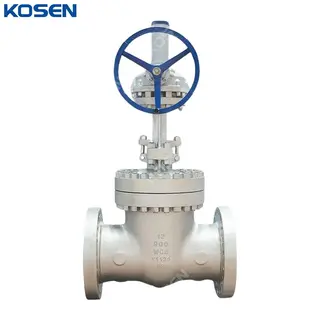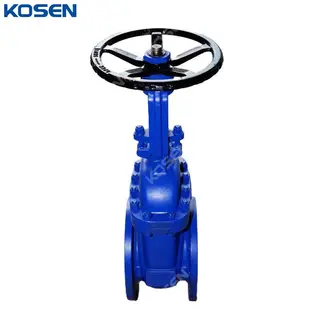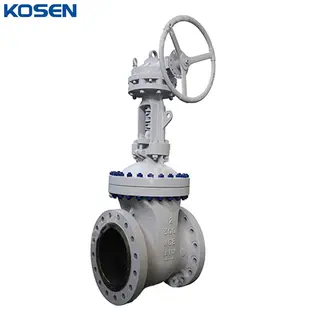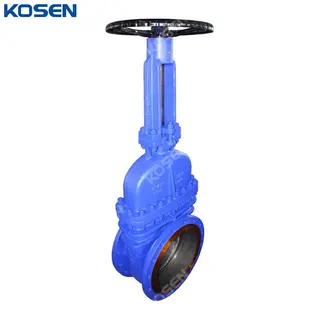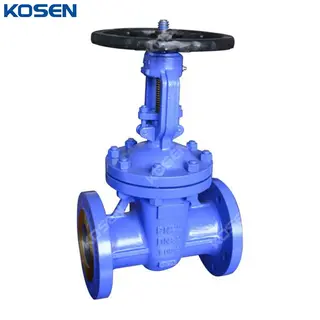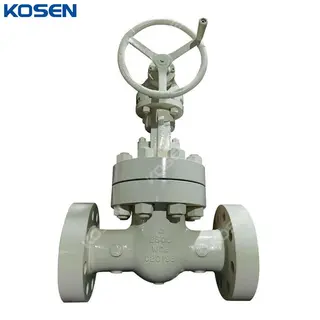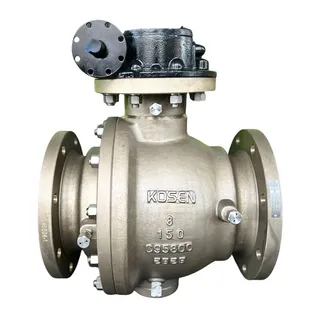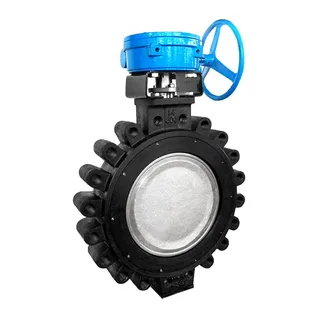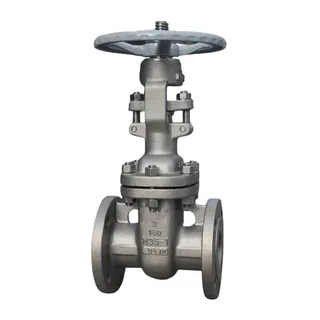Gate valves are devices used to control the flow of fluids through a pipeline by moving a gate perpendicular to the flow direction. These valves are typically employed for full open or full close operations and are unsuitable for regulating flow or throttling. They are especially prevalent in pipelines with a nominal diameter of DN50, but can also be found in smaller diameter systems.
Gate valves are best suited for situations where the valve needs to either be fully open or fully closed. When fully open, the fluid passage is straight through, minimizing pressure loss. However, gate valves are not ideal for regulating or throttling due to the potential for vibration from high-speed fluids, which may damage the sealing surfaces or cause erosion.
The gate, which serves as the valve's opening and closing element, moves in a direction perpendicular to the flow of the fluid. Typically, the gate has two sealing surfaces, which are often designed in a wedge shape. The angle of the wedge may vary depending on the valve parameters, with typical angles ranging from 5° to 2°52' for lower temperatures. The gate can be either rigid or elastic. A rigid gate is a single, solid piece, while an elastic gate can compensate for slight misalignments in the sealing surface during manufacturing through minimal deformation.
When the gate valve is closed, the pressure of the fluid helps create a self-sealing effect by pressing the gate against the valve seat. Most gate valves employ forced sealing, meaning that external force is needed to press the gate against the seat to ensure a tight seal.
Gate valves usually feature a rising stem design, where the stem moves in a linear motion along with the gate. The stem is threaded with trapezoidal threads, which convert rotational motion into linear motion, enabling the opening and closing of the valve. When the gate reaches the height equal to the diameter of the valve, the fluid passage is fully open. Alternatively, some gate valves use a rotating stem design, where the stem nut is located on the gate and the handwheel drives the stem to lift the gate.
In practical applications, the full open position of the valve is typically determined by the position of the top of the stem, which corresponds to the maximum operating thrust. To prevent seizing due to temperature variations, the valve is often backed off by 1/2 to 1 turn after reaching the full open position, ensuring the valve remains fully open.
Gate valves can be categorized based on their construction, each type suited for different operational conditions and application needs.
Parallel Gate Valve: This type features two parallel sealing surfaces on the gate, which align with the valve's vertical centerline. It is suitable for low-pressure applications and environments where scaling is minimal.
Wedge Gate Valve: The gate's sealing surfaces are wedge-shaped, angled at a specific degree to the valve's centerline. Wedge gate valves can be further divided into:
Single Gate Wedge Valve: This structure requires high precision in sealing surface angles, is more difficult to manufacture, and can be challenging to maintain.
Double Gate Wedge Valve: Compared to single-gate valves, double-gate wedge valves are more forgiving in terms of sealing surface precision and can compensate for seal wear by adding gaskets. However, the increased number of components can lead to sticking in viscous media, affecting sealing performance. These valves are commonly used in water and steam pipelines.
Elastic Seat Gate Valve: This is the most widely used type, combining the simplicity and reliability of a single-gate design with improved sealing performance through minor elastic deformation, enhancing the valve's reliability and performance.
Rising Stem Gate Valve: In this design, the stem nut is located above the valve bonnet or bracket, and the rotation of the stem nut controls the movement of the stem, which in turn moves the gate. The advantages include easy lubrication, longer stem life, and observable open/close status, making it easier to operate and maintain. However, it requires a large installation space and is less compact, especially in constrained environments.
Non-Rising Stem Gate Valve: The stem nut is positioned inside the valve body and is in direct contact with the flow media. Rotating the stem opens and closes the gate. The advantages include smaller installation space and a more compact design. However, the stem's internal threads can suffer erosion from the media, leading to wear and damage.
Gate valves are made up of several key components that work together to ensure smooth operation, sealing performance, and durability. These components include the valve body, bonnet, stem, gate, seat, and actuators.
Valve Body: The body is the central part of the gate valve, usually made of cast iron, and connects directly to the pipeline. It supports the pressure exerted by the medium and houses the seat, bonnet, and other components. The method of manufacturing the body can vary, with casting used for DN50 and larger sizes and forging or welding for smaller or more complex applications.
Bonnet: The bonnet connects to the valve body and forms the pressure chamber. It usually houses a stuffing box to seal the contact area between the stem and body. For smaller and medium-sized valves, the bonnet may also support the stem nut or actuator mechanism.
Stem: The stem connects the body to the gate and transmits the torque needed to lift the gate. The stem's threaded portion forms a seal with the stuffing box to prevent leaks. Gate valves can be categorized into rising stem and non-rising stem designs based on stem configuration.
Gate: The gate is the element that controls the flow. Its design and material directly influence the sealing performance and service life of the valve.
Seat: The seat forms a sealing surface with the gate and is typically secured to the valve body by welding, rolling, or threading. For high-performance valves, the seat design can directly impact the efficiency and sealing of the valve.
Actuator: The actuator transmits force to the stem or stem nut. Common actuation methods include handwheels, gearboxes, and electric or pneumatic actuators.
Gate valves are used across various industries due to their reliable sealing and precise flow control capabilities, making them ideal for handling different types of fluid media.
Chemical, Petrochemical, and Oil Industries: Gate valves control the flow of oil, water, steam, and other media, often in corrosive or hazardous environments, ensuring safe and stable operation in production processes.
Pulp and Paper, Mining Industries: Gate valves are used to isolate or connect media in fluid transport systems, improving energy efficiency and ensuring smooth operations on production lines.
Power Industry: In thermal power plants, gate valves regulate the flow of steam and water, ensuring efficient plant operation by adhering to relevant technical standards.
Liquefied Gas, Food, and Pharmaceutical Industries: Gate valves ensure the purity and safe handling of media, which is critical in industries where the purity of the fluid is paramount.
Water Supply and Municipal Systems: Gate valves are essential in controlling the flow of water and wastewater, preventing leakage, and ensuring the safety of municipal water and sewage systems.
Mechanical, Electronics, and Construction Industries: Gate valves are used to control fluid flow in various systems, ensuring the efficiency and stability of these systems.
Gate valves are a commonly used valve type, offering several advantages but also presenting certain drawbacks that should not be overlooked.
Low Fluid Resistance: The internal channel design of the gate valve is straight-through, meaning the fluid flows through the valve without changing direction, resulting in minimal resistance.
Low Operating Torque and Effortless Opening and Closing: The movement of the gate is perpendicular to the flow direction, which makes gate valves easier to open and close compared to globe valves, requiring less force and effort.
Unrestricted Fluid Flow Direction: The fluid can flow in either direction through the gate valve, making it suitable for piping systems where the flow direction may change, without causing flow disruption or pressure reduction.
Compact Length: Gate valves have a shorter structure compared to globe valves because their gates are positioned vertically within the valve body, while globe valves have horizontal disc configurations. This compactness reduces installation space requirements.
Good Sealing Performance: When fully open, the sealing surfaces of a gate valve are less exposed to the erosive effects of the working medium, providing better sealing performance compared to globe valves.
Minimal Flow Resistance and Low Effort for Opening/Closing: The straight-through design minimizes flow resistance, and the opening/closing process is easier, especially in comparison to globe valves.
Reduced Risk of Water Hammer: Due to the gradual opening and closing process of gate valves, there is a lower chance of water hammer phenomena, which often occur during rapid valve operation.
Versatile Installation: Gate valves can be installed in environments with limited space due to their compact design, and their bi-directional flow capability offers flexibility.
Durability: The simple structure and use of corrosion-resistant materials such as stainless steel and hard alloys for sealing surfaces ensure that gate valves are durable and provide reliable sealing over long service lives.
2. Main Disadvantages of Gate Valves
Vulnerable Sealing Surfaces: During operation, the gate may come into relative friction with the seat, which can cause wear and tear of the sealing surfaces, potentially affecting sealing performance and shortening the valve's service life.
Longer Opening/Closing Time and Height: Due to the larger travel distance of the gate, the valve requires more time to open and close. Additionally, gate valves have a taller structure, increasing their installation space requirements.
Complex Structure: Gate valves typically have two sealing surfaces, which increases the difficulty of manufacturing, polishing, and maintenance. The presence of more components results in higher manufacturing and maintenance costs.
Significant Wear: The friction between the sealing surfaces during operation is relatively high, particularly at elevated temperatures, which can cause wear and impact the valve's sealing ability and lifespan.
Large Installation Space Requirements: The relatively large physical dimensions of gate valves require more installation space, making them less suitable for environments with limited room.
When choosing the appropriate gate valve, several factors such as the medium characteristics, working environment, frequency of use, and installation space must be considered. Based on different requirements, gate valves are available in two main types: parallel gate valves and wedge gate valves.
Medium Range: Water, steam, oils, oxidizing corrosive media (e.g., Z42W-16Ti), acidic and alkaline flue gases, etc.
Applications: Suitable for steam, high-temperature oils, and oil-gas mediums, particularly in applications with frequent opening and closing. However, not recommended for mediums prone to coking.
Suggested Use:
Urban gas pipeline systems: Single-gate or double-gate soft-sealed rising stem parallel gate valves.
Urban water projects: Single-gate or double-gate non-flow hole rising stem parallel gate valves.
Pipelines with suspended particulate matter: Knife gate valves are recommended to withstand particle impact.
Applications: Best suited for fully open or fully closed applications, not intended for regulation or throttling. Commonly used in high-temperature, high-pressure media and environments where valve dimensions are not strictly specified but require long-term sealing performance.
Recommended Conditions:
High-temperature, high-pressure media (e.g., steam, high-temperature oils).
Low-temperature, cryogenic media (e.g., liquid ammonia, liquid hydrogen, liquid oxygen).
Low-pressure, large-diameter pipelines for water supply and sewage treatment projects.
Special Applications: High-temperature media: Wedge gate valves with single or double gates are suitable for coking-prone substances.
Installation Height Limitations: If space is limited, choose a non-rising stem gate valve; if height is not a constraint, a rising stem gate valve is preferred.
Switching Frequency: Wedge gate valves are recommended for applications requiring frequent opening and closing.
Valve Type: Wedge gate valves are ideal for high-temperature, low-temperature, cryogenic, or high-pressure applications.
To ensure stable and long-term operation of gate valves, careful installation is essential. Here are some key installation requirements and considerations:
Cleanliness Check: Before installation, ensure that the valve body is free of impurities that may clog the pipeline and affect fluid flow. Pay special attention to valve seats and sealing components to avoid damage from foreign particles.
Valve Body and Seal Check: Inspect the valve body and sealing surfaces for any damage, as even minor imperfections can lead to leaks or improper sealing. Ensure the valve stem is vertical and free of misalignment to ensure smooth operation.
Installation Position: Install the gate valve in a location that facilitates daily operation and maintenance. The handwheel should be positioned upward and not tilted for easy operation.
Installation Force Control: Be cautious when installing the valve, especially for brittle valve materials. Excessive installation force can cause damage, especially when improper tools or excessive force are used.
External Protection Measures: For gate valves in specialized environments, consider insulation or cooling measures to protect the valve from temperature extremes, preventing damage or freezing.
Gate Valve Maintenance and Care
Regular maintenance is crucial for ensuring the long-term stable performance of gate valves. Through periodic inspection, cleaning, lubrication, and replacement of worn components, the valve's service life can be extended and the risk of failures reduced. Here are the main maintenance tasks and precautions:
Regular Inspection: Ensure that valve components, such as the valve body, stem, sealing surfaces, and fasteners, are intact. Focus on the following:
Opening and Closing Function: Check for smooth operation and avoid difficulties caused by jams or misalignments.
Sealing Performance: Inspect the sealing surfaces for leaks or corrosion.
Fastener Condition: Tighten bolts and nuts to prevent leaks or valve failure.
Regular Cleaning: Gate valves can accumulate dirt and debris, so regular cleaning is necessary. Use suitable cleaners to prevent damage to the valve body and seals, ensuring that the valve is thoroughly cleaned to avoid clogging.
Lubrication Maintenance: Regularly lubricate parts like the stem and bearings to ensure smooth operation. Ensure that the lubricant supply is adequate and choose the appropriate lubricant based on the operating environment.
Replacement of Worn Components: Seals, gaskets, and packing wear over time. Replace these components promptly when damaged or aged to ensure proper sealing and prevent leaks.
Corrosion Protection: Use anti-corrosion coatings and materials to protect gate valves from corrosion and oxidation, especially in harsh environments. Regularly inspect the coating and reapply if damaged.
Gate valves may experience issues such as external or internal leakage due to factors like medium temperature, pressure, corrosion, and relative motion between contact components.
External Leakage: Occurs at the packing gland or flange connections. Potential causes include substandard packing, aging packing, stem wear, loose packing nuts, or damaged stem surfaces.
Internal Leakage: Caused by improper sealing, typically due to damaged sealing surfaces or inadequate sealing ring performance.
Corrosion Issues: Often affects the valve body, cover, stem, and flange sealing surfaces due to the interaction with the medium or ions released by packing and gaskets.
Packing Tightening: Tighten the packing bolts symmetrically to avoid tilting and ensure uniform compression.
Flange Leakage: Replace damaged gaskets, select appropriate materials, rework the sealing surface, and optimize pipeline configuration.
Internal Leakage: Replace sealing rings or repair sealing surfaces. Use PTFE tape or a thick white coating to seal the root of the fixed sealing ring.
Corrosion Repair: Remove corrosion products, repair pitting on the stem, and use corrosion inhibitors or distilled water to clean packing.
In conclusion, gate valves are essential components in fluid and gas handling systems, providing reliable and efficient isolation capabilities. Their simple structure, ease of operation, and minimal flow resistance make them ideal for applications requiring full open or full closed positions. However, care must be taken in selecting the right type of gate valve for specific operational conditions, as the valve's sealing surfaces and overall design may impact its performance over time. Regular maintenance and proper installation practices are key to ensuring the long-term functionality and durability of gate valves in diverse industrial applications.
